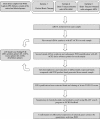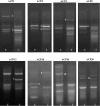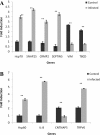Cellular transcripts of chicken brain tissues in response to H5N1 and Newcastle disease virus infection
- PMID: 22361110
- PMCID: PMC3297529
- DOI: 10.1186/1743-422X-9-53
Cellular transcripts of chicken brain tissues in response to H5N1 and Newcastle disease virus infection
Abstract
Background: Highly-pathogenic avian influenza (HPAI) H5N1 and Newcastle disease (ND) viruses are the two most important poultry viruses in the world, with the ability to cause classic central nervous system dysfunction in poultry and migratory birds. To elucidate the mechanisms of neurovirulence caused by these viruses, a preliminary study was design to analyze host's cellular responses during infections of these viruses.
Methods: An improved mRNA differential display technique (Gene Fishing™) was undertaken to analyze differentially expressed transcripts regulated during HPAI H5N1 and velogenic neurotropic NDV infections of whole brain of chickens. The identification of differentially expressed genes (DEGs) was made possible as this technique uses annealing control primers that generate reproducible, authentic and long PCR products that are detectable on agarose gels.
Results: Twenty-three genes were identified to be significantly regulated during infections with both viruses, where ten of the genes have been selected for validation using a TaqMan® based real time quantitative PCR assay. Some of the identified genes demonstrated to be key factors involving the cytoskeletal system, neural signal transduction and protein folding during stress. Interestingly, Septin 5, one of the genes isolated from HPAI H5N1-infected brain tissues has been reported to participate in the pathogenic process of Parkinson's disease.
Conclusions: In this limited study, the differentially expressed genes of infected brain tissues regulated by the viruses were found not to be identical, thus suggesting that their neurovirulence and neuropathogenesis may not share similar mechanisms and pathways.
Figures




References
-
- Cumulative Number of Confirmed Human Cases of Avian Influenza A/(H5N1) Reported to WHO. http://www.who.int/csr/disease/avian_influenza/country/cases_table_2011_...
-
- Update on Highly Pathogenic Avian Influenza in Animals (Type H5 and H7) http://www.oie.int/animal-health-in-the-world/update-on-avian-influenza/...
Publication types
MeSH terms
LinkOut - more resources
Full Text Sources
Medical

